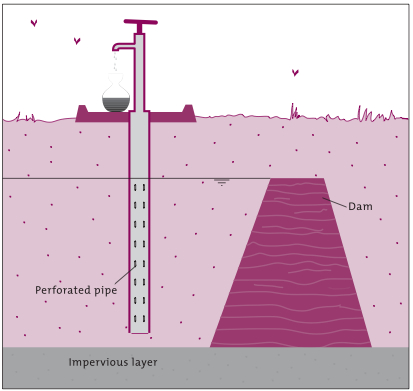Subsurface harvesting systems
The use of sub-surface dams in naturally occurring alluvium creates groundwater storage upstream of the dam, raising the water table and preventing evaporation losses. A subsurface dam is constructed across a valley is a seasonally dry, sandy riverbed, by digging a trench down to the bedrock or other impervious layer. The dam, which is placed in the trench, may consist of a wall or screen and covered with excavated material until it is completely concealed. The refill material must be properly compacted.
Contents
Suitable conditions
- Seasonal rivers in semi-arid regions with permeable sediments and an impervious layer at a shallow depth (maximum 3 to 4m deep).
- River valleys with gradients of between 1 and 2% usually enable the highest storage.
- Ideal where groundwater flow converges from a large catchment into a narrow passage.
| Advantages | Disadvantages/limitations |
|---|---|
| - Subsurface dams are not likely to deteriorate, with little danger of breaching - Construction has long lifespan and require minimal maintenance |
- Leakage is often difficult to detect - Downwater flow will be impacted to communities downstream |
Construction, operations and maintenance
Costs
- Materials costs and construction: US$1,400
- Feasibility study: US$200
- Technical support: US$275
- Operation and maintenance: low
Field experiences
A subsurface reservoir in Pernambuco, Brazil has an average depth of 4m, is 50m wide, and 500m long, storing about 4,000m3 of water.

